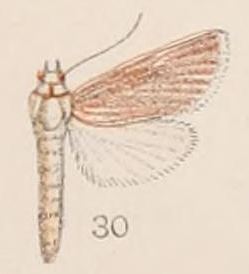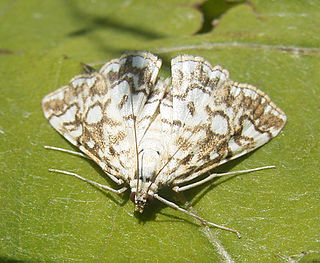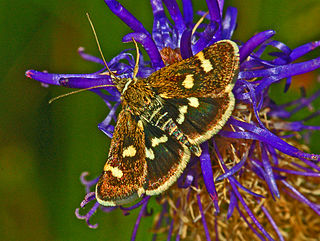
Pyraustinae is a large subfamily of the lepidopteran family Crambidae, the crambid snout moths. It currently includes over 1,400 species, the majority of them tropical but some found in temperate regions including both North America and Europe.

Spilomelinae is a very large subfamily of the lepidopteran family Crambidae, the crambid snout moths. They were formerly included in the Pyraustinae as tribe Spilomelini; furthermore taxonomists' opinions differ as to the correct placement of the Crambidae, some authorities treating them as a subfamily (Crambinae) of the family Pyralidae. If this is done, Spilomelinae is usually treated as a separate subfamily within Pyralidae. The Spilomelinae are believed to be polyphyletic. Many genera are only tentatively placed here even at this point.

Crambinae is a large subfamily of the lepidopteran family Crambidae, the crambid snout moths. It currently includes over 1,800 species worldwide. The larvae are root feeders or stem borers, mostly on grasses. A few species are pests of sod grasses, maize, sugar cane, rice, and other Poaceae. The monophyly of this group is supported by the structure of the tympanal organs and the phallus attached medially to the juxta.
Cisthene is a genus of lichen moths in the family Erebidae. The genus was erected by Francis Walker in 1854.
Eucereon is a genus of tiger moths in the family Erebidae.
Bradina is a genus of moths of the family Crambidae.
Erupa is a genus of moths of the family Crambidae.
Glyphodes is a genus of moths of the family Crambidae described by Achille Guenée in 1854.

Lamprosema is a genus of moths of the family Crambidae described by Jacob Hübner in 1823.

Patissa is a genus of moths of the family Crambidae described by Moore in 1886.
Piletocera is a genus of moths of the family Crambidae. The genus was first described by Julius Lederer in 1863.
Syllepte is a genus of moths of the family Crambidae.

Hydrelia is a genus of moths in the family Geometridae.

Acentropinae is a fairly small subfamily of the lepidopteran family Crambidae, the crambid snout moths. Species of this subfamily are exclusively found in wetlands and aquatic habitats.

Odontiinae is a subfamily of moths of the family Crambidae. The subfamily was described by Achille Guenée in 1854.
Schoenobiinae is a subfamily of the lepidopteran family Crambidae. The subfamily was described by Philogène Auguste Joseph Duponchel in 1846.






